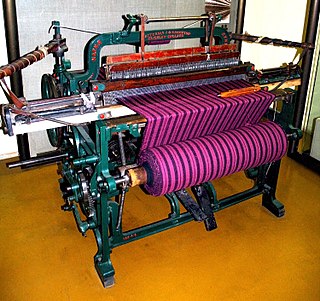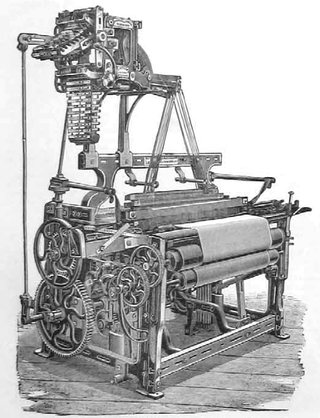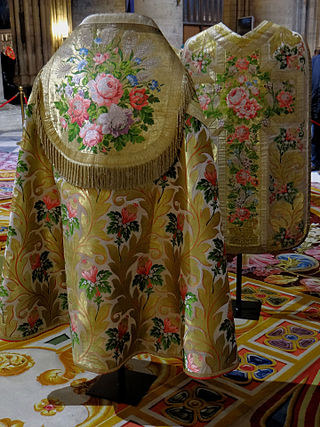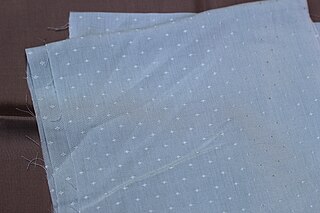
The Jacquard machine is a device fitted to a loom that simplifies the process of manufacturing textiles with such complex patterns as brocade, damask and matelassé. The resulting ensemble of the loom and Jacquard machine is then called a Jacquard loom. The machine was patented by Joseph Marie Jacquard in 1804, based on earlier inventions by the Frenchmen Basile Bouchon (1725), Jean Baptiste Falcon (1728), and Jacques Vaucanson (1740). The machine was controlled by a "chain of cards"; a number of punched cards laced together into a continuous sequence. Multiple rows of holes were punched on each card, with one complete card corresponding to one row of the design.

A loom is a device used to weave cloth and tapestry. The basic purpose of any loom is to hold the warp threads under tension to facilitate the interweaving of the weft threads. The precise shape of the loom and its mechanics may vary, but the basic function is the same.

Weaving is a method of textile production in which two distinct sets of yarns or threads are interlaced at right angles to form a fabric or cloth. Other methods are knitting, crocheting, felting, and braiding or plaiting. The longitudinal threads are called the warp and the lateral threads are the weft, woof, or filling. The method in which these threads are interwoven affects the characteristics of the cloth. Cloth is usually woven on a loom, a device that holds the warp threads in place while filling threads are woven through them. A fabric band that meets this definition of cloth can also be made using other methods, including tablet weaving, back strap loom, or other techniques that can be done without looms.
Ikat is a dyeing technique from Indonesia used to pattern textiles that employs resist dyeing on the yarns prior to dyeing and weaving the fabric. The term is also used to refer to related and unrelated traditions in other cultures. In Southeast Asia, where it is the most widespread, ikat weaving traditions can be divided into two general clades. The first is found among Daic-speaking peoples. The second, larger group is found among the Austronesian peoples and spread via the Austronesian expansion. Similar dyeing and weaving techniques that developed independently are also present in other regions of the world, including India, Central Asia, Japan, Africa, and the Americas

A dobby loom, or dobbie loom, is a type of floor loom that controls all the warp threads using a device called a dobby.

Damask is a reversible patterned fabric of silk, wool, linen, cotton, or synthetic fibers, with a pattern formed by weaving. Damasks are woven with one warp yarn and one weft yarn, usually with the pattern in warp-faced satin weave and the ground in weft-faced or sateen weave. Twill damasks include a twill-woven ground or pattern.

Jamdani is a fine muslin textile produced for centuries in South Rupshi of Narayanganj district in Bangladesh on the bank of Shitalakhwa river.

The quechquemitl is a garment which has been worn by certain indigenous ethnicities in Mexico since the pre-Hispanic period. It usually consists of two pieces of rectangular cloth, often woven by hand, which is sewn together to form a poncho or shawl like garment, which is usually worn hanging off the shoulders. It can be constructed of various different fabrics, often with intricate weaves, and is typically highly decorated, most often with embroidery.
Maya textiles (k’apak) are the clothing and other textile arts of the Maya peoples, indigenous peoples of the Yucatán Peninsula in Mexico, Guatemala, Honduras, El Salvador and Belize. Women have traditionally created textiles in Maya society, and textiles were a significant form of ancient Maya art and religious beliefs. They were considered a prestige good that would distinguish the commoners from the elite. According to Brumfiel, some of the earliest weaving found in Mesoamerica can date back to around 1000-800 B.C.E.

Silk In India, about 97% of the raw mulberry silk is produced in the Indian states of Karnataka, Andhra Pradesh, Tamil Nadu and West Bengal. Mysore and North Bangalore, the upcoming site of a US$20 million "Silk City", contribute to a majority of silk production. Another emerging silk producer is Tamil Nadu where mulberry cultivation is concentrated in Salem, Erode and Dharmapuri districts. Hyderabad, Andhra Pradesh and Gobichettipalayam, Tamil Nadu were the first locations to have automated silk reeling units.
The manufacture of textiles is one of the oldest of human technologies. To make textiles, the first requirement is a source of fiber from which a yarn can be made, primarily by spinning. The yarn is processed by knitting or weaving, which turns yarn into cloth. The machine used for weaving is the loom. For decoration, the process of colouring yarn or the finished material is dyeing. For more information of the various steps, see textile manufacturing.

Brocade is a class of richly decorative shuttle-woven fabrics, often made in colored silks and sometimes with gold and silver threads. The name, related to the same root as the word "broccoli", comes from Italian broccato meaning "embossed cloth", originally past participle of the verb broccare "to stud, set with nails", from brocco, "small nail", from Latin broccus, "projecting, pointed".
Band weaving refers to the hand production of narrow woven fabric. This fabric may be called tape, band, inkle, strap, belt, back strap, trim, and more. It can be accomplished on a variety of types of looms, including inkle, band, tape, backstrap, and rigid heddle looms. Hole and slot heddles are also designed to weave bands. Depending on which loom is used, the material could be warp-faced or a balanced weave.

A woven coverlet or coverlid is a type of bed covering with a woven design in colored wool yarn on a background of natural linen or cotton. Coverlets were woven in almost every community in the United States from the colonial era until the late 19th century.

Amuzgo textiles are those created by the Amuzgo indigenous people who live in the Mexican states of Guerrero and Oaxaca. The history of this craft extends to the pre-Columbian period, which much preserved, as many Amuzgos, especially in Xochistlahuaca, still wear traditional clothing. However, the introduction of cheap commercial cloth has put the craft in danger as hand woven cloth with elaborate designs cannot compete as material for regular clothing. Since the 20th century, the Amuzgo weavers have mostly made cloth for family use, but they have also been developing specialty markets, such as to collectors and tourists for their product.

Dobby, or dobbie, is a woven fabric produced on the dobby loom, characterised by small geometric patterns and extra texture in the cloth. The warp and weft threads may be the same colour or different. Satin threads are particularly effective in this kind of weave as their texture will highlight the pattern.
An air-jet loom is a shuttleless loom that uses a jet of air to propel the weft yarn through the warp shed. It is one of two types of fluid-jet looms, the other being a water-jet loom, which was developed previously. Fluid-jet looms can operate at a faster speed than predecessor looms such as rapier looms, but they are not as common. The machinery used in fluid-jet weaving consists of a main nozzle, auxiliary nozzles or relay nozzles, and a profile reed.

The Game of Thrones Tapestry is a hand-crafted tapestry, woven by hand on a jacquard loom, with additional embroidery. The tapestry tells the entire story of the television show, Game of Thrones. It consists of seven 11-metre-long panels and one 10.5-metre panel. The eight panels depict scenes from each episode and include images of crew at work. The tapestry was commissioned by HBO and Tourism Ireland, the tourism bureau of Northern Ireland where HBO filmed much of the series.

Brocatelle is a silk-rich fabric with heavy brocade designs. The material is characterized by satin effects standing out in relief in the warp against a flat ground. It is produced with jacquard weave by using silk, rayon, cotton, or many synthetic yarns.

The swivel weave is a weaving technique that incorporates a decorative element into the fabric by using small shuttles that insert additional weft thread around selected warp threads, while the main weft thread forms the fabric's structure. This method differs from the plain weave, which lacks this decorative aspect.


















